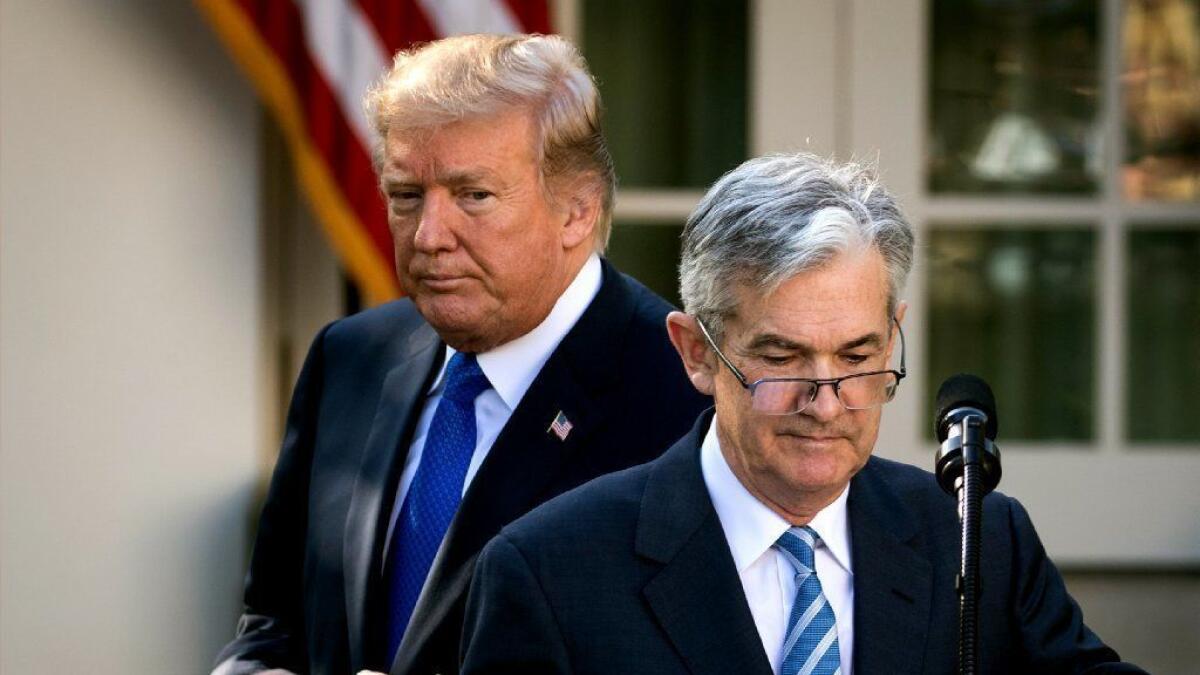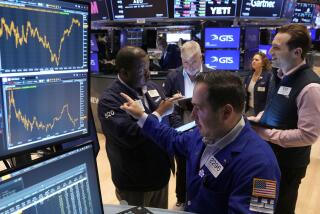Is the Federal Reserve about to cave to Trump’s demand to cut interest rates?

Reporting from Washington — President Trump has been hectoring the Federal Reserve to lower interest rates, and financial markets are screaming for a cut. This even though rates are historically low and the economy is sailing along, albeit with some recent gray clouds.
What’s a central bank to do?
Fed policymakers are expected to stand pat on rates after their two-day meeting Wednesday. But it looks as if they already may have backed themselves into a corner.
In recent weeks the Fed and its chairman, Jerome Powell, have signaled they’re prepared to lower rates if the outlook worsens. Just three months ago, they were favoring a rate hike or no action.
Failure now to cut rates — or a pivot back to a rate hike or even a neutral stance — could cause a violent sell-off by markets, or cost Powell his job.
But neither does the Fed want to be bossed around by markets, nor seen as doing the president’s bidding, which could hurt its credibility and weaken the independence that the Fed has long fought to preserve.
“If they do cut [rates], they will be accused of caving to Trump,” said Alan Blinder, a Princeton professor and former Fed vice chair in the mid-1990s. Trump “will of course claim victory. He will say, ‘The dumb Fed finally learned to listen to me.’ ”
The Fed shift to a rate-cut bias comes at a particularly sensitive time. Trump wants to pump up growth ahead of the 2020 election and cushion the economic damage from his escalating trade war with China.
At less than 2.5%, the Fed’s main benchmark rate remains low by historical standards, meaning that any cuts at this point would further limit the central bank’s ability to fight a recession when it strikes.
Trump has been relentless in excoriating the Fed and demanding that it reverse rate hikes made last year.
Over the last year he has called the Federal Reserve “crazy,” “wild” and “loco.” As recently as last week, he again blamed the bank for its “big mistake” in raising rates, saying on CNBC: “It’s more than just Jay Powell. We have people on the Fed that really weren’t — they’re not my people.”
Trump has openly expressed dissatisfaction with Powell, whom he handpicked to replace Janet L. Yellen as Fed chair early last year. He reportedly has considered removing Powell from Fed leadership, although it’s not clear whether he has the authority to do so.
On Tuesday afternoon, before boarding Marine One for Orlando, where he will kick off his 2020 reelection campaign, Trump was asked whether he was thinking about demoting Powell. “Let’s see what he does,” Trump said. “I want to be given a level playing field, and so far I haven’t been.”
In recent months the president also has sought, unsuccessfully, to fill two Fed board openings with people who are inclined to follow his lead.
“We might conclude that Trump’s gotten into their heads,” said Mark Zandi, chief economist at Moody’s Analytics, agreeing that many will see a rate cut as acquiescence to Trump’s demands. Trump, he added, “may use that [rate cut] as an opportunity to double down on his trade war.”
Powell and his colleagues insist that Fed policy will be driven by economic data, and there are signs of slowing U.S. growth. Domestic manufacturing has weakened, and both government bond yields and inflation measures are signaling possible trouble ahead, caused in part by a resumption of tit-for-tat tariffs between the United States and China.
Yet it’s hard to know whether the inflation numbers of late are transitory, as Powell has previously said, and just how much a widening dispute with China will affect growth.
Trade talks between the two largest economies broke down last month, and there’s been little movement since. On Tuesday, the White House confirmed that Trump and Chinese President Xi Jinping would meet on the sidelines of a global economic summit at the end of next week in Japan, just as they did last year at the Group of 20 summit in Argentina when they agreed to a cease-fire.
Commerce Secretary Wilbur Ross suggested Monday that a restart of negotiations could follow the meeting. Trump tweeted Tuesday that he and Xi had a “very good telephone conversation,” prompting a big rally on Wall Street.
Trade with China accounts for a tiny share of the American economy, and its disruption isn’t likely to derail growth. Next month will mark the longest sustained period of U.S. economic growth, surpassing the 10-year expansion in the 1990s. And by most accounts, the economy will continue to grow at a decent 2% pace for the foreseeable future. The Fed will update its economic forecast on Wednesday.
With greater uncertainties because of trade and inflation, however, experts say it’s reasonable for the Fed to guard against rising downside risks to the economy. Although policymakers typically cut rates after they gather evidence of a threatening recession, the Fed sought to get out ahead with rate cuts during the Asian financial crisis in the late 1990s.
Trump isn’t alone in faulting the Fed for raising rates aggressively last year — it hiked them four times, the last in December. Soon after that the Fed pivoted away from its rate-hike posture, but not before stocks were hammered.
Financial markets have bounced up and down this year, but jumped back near record levels in the wake of Powell’s speech early this month in Chicago when he said the Fed “will act as appropriate to sustain the expansion.”
Some analysts say financial markets misunderstood the Fed, overreacting to Powell’s comments and taking them as a signal of rate cuts later this year.
Other analysts said it would have been better for Powell to say nothing rather than suggest a willingness to cut rates. Stock markets were still up for the year. And there weren’t indications that the U.S. economy had veered from its growth path, unless the Fed saw more trouble lurking that no one else had.
“I think they may have blown it. The Fed encouraged the market to [bet on] too many rate cuts,” said Chris Rupkey, managing director and chief economist at MUFG Union Bank in New York.
But even if rate cuts in coming months are meant to function as insurance against a downturn, it’s uncertain how much good they would do. Rupkey noted that rates already are so low that interest-sensitive sectors, such as housing and car sales, aren’t likely to get much of a boost.
“The Fed’s total influence on the economy will be limited,” said Lynn Reaser, a longtime Fed watcher and chief economist at Point Loma Nazarene University in San Diego.
The Fed’s main rate is a benchmark for credit cards, auto loans and other short-term consumer lending. The bank kept its key rate near zero for several years after the Great Recession but since late 2015 has boosted it gradually to between 2.25% and 2.5%, where it currently stands.
On Wednesday, most Fed officials are expected to indicate that a couple of rate cuts are probably in store for later this year. That would be a marked shift from mid-March when 11 of 17 Fed officials saw no change in interest rates while the rest expected one or two quarter-point rate increases for 2019.
Gary Richardson, a former Fed historian who teaches economics at UC Irvine, says the Fed’s dilemma now is complicated by the fact that it doesn’t have a strong track record of predicting how trade wars spill over into the economy. “There’s no tariffs or trade war in their models,” he said.
As they head into uncharted waters, Fed officials may want to avoid making things worse by moving too aggressively to restrict growth, Richardson said.
“If they’re going to screw up, they’d rather lower rates when they shouldn’t, instead of raising rates.”
More to Read
Get the L.A. Times Politics newsletter
Deeply reported insights into legislation, politics and policy from Sacramento, Washington and beyond. In your inbox three times per week.
You may occasionally receive promotional content from the Los Angeles Times.











